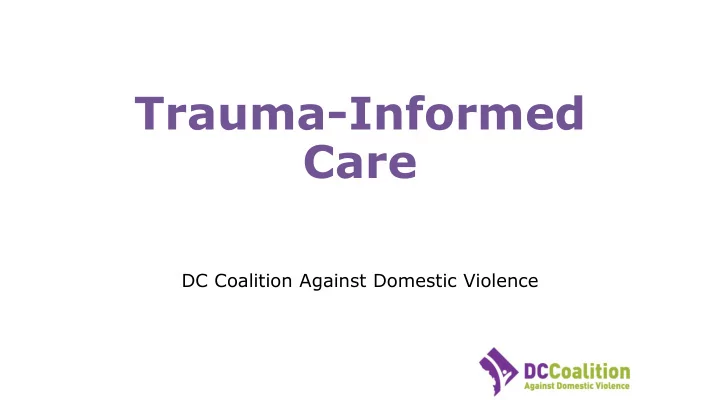

Trauma-Informed Care DC Coalition Against Domestic Violence
Understanding Trauma What is trauma? Is there a difference between trauma and a crisis? Trauma: from the Latin word meaning wound Crisis: too much, too fast, too soon
Impacts of Trauma • Psychological/emotional • Physical responses to responses to trauma: trauma: • Anxiety • Body aches (headache, back pain, etc.) • Depression • Gastrointestinal issues • Problems regulating affect • Circulatory system issues (high • Withdrawal blood pressure, heart palpitations, etc.) • Changes in eating and sleeping • Cognitive responses to trauma: • Inability to organize thoughts • Poor memory/forgetfulness • Poor judgment • Difficulty making decisions
Behavioral Consequences of Trauma • State of persistent fear: hypervigilance, easy startle response • Problems with memory: difficulty remembering what happened, non-linear, inconsistent versions, flashbacks, intrusive memories • Difficulty regulating affect: unable to stop crying, uncontrollable anger, “inappropriate” laughter, numbness, no emotion • Avoidance: not able to make decisions, avoiding anything that reminds them of the violence
Addressing Trauma: Person Centered Which do you choose?
Person Centered • A person-centered approach recognizes that each individual is unique, and is the expert of their own experience • Not population specific, but person specific • Knowing one aspect of a person’s identity does not mean we can predict how they’ll act or what they need • Not every person in a population responds to trauma in the same way
Person Centered • How do we practice person-centered approaches in our work? • Ask pronouns & how they’d like to be identified • Explain your role and what they can expect • Ask about preference for receiving information • Get consent before any physical contact (handshakes, etc.) • Do your best to help them feel safe and comfortable – what do they need? • Provide informed consent about how information is shared and with whom
Addressing Trauma: Choice
Building Choice • Flexibility at intake/entrance to program • Options given during their time in program • Choice in referrals/next steps In order to empower clients & build self-determination, choice is needed at programmatic and systems level
Challenges & Barriers to Addressing Trauma
Challenges & Barriers • Why is it challenging to hold up these three tenants (person-centered and choice) in our work? • Lack of private space • Not enough time for each client • Concerns client may take advantage of staff/the program • Staff don’t have enough power or support
Challenges & Barriers • Despite the challenges, what are the benefits of being person-centered and offering choice? • Better relationships with clients • Building client self-determination and empowerment • Feels better for staff • Proven effective in evidence-based research
Trauma-Informed Care • Shift in thinking about trauma: focus not on the incident, but on the impact • Trauma-informed care: focus not on a checklist or to-do list, but on a practice
Trauma-Informed Care Organizations and practices that incorporate an understanding of the pervasiveness and impact of trauma, including an understanding that a person is the expert of their own trauma. These organizations and practices are designed to reduce retraumatization, support healing and resiliency, promote safety for survivors and staff, and recognize the root causes of oppression, abuse and violence.
Trauma-Informed Care • Providing trauma-informed care means: • Thinking in a person-centered way • Honoring confidentiality and privacy • Providing options, flexibility, and choice • These best practices are proven to reduce trauma symptoms for both clients & staff
Questions?
Recommend
More recommend